Viruses are exceptions to the cell theory, but they have some characteristics of living things. What is one of these characteristics? 1. They are made up of many specialized cells. 2. They contain genetic material. 3. They reproduce by mitosis. 4. They contain chlorophyll.
2. They contain genetic material.
Proteins, starch, and DNA are similar in that they are all 1. organic compounds 2. parts of genes 3. made of amino acids 4. made of simple sugars
1. organic compounds
Canus nipponicus refers to a proposed scientific name for an imaginary organism. This proposed scientific name indicates the: 1. kingdom and phylum 2. phylum and genus 3. genus and species 4. kingdom and species
3. genus and species
Which organelle contains the enzymes needed to synthesize ATP in the presence of oxygen? 1. Mitochondria 2. Golgi body 3. Endoplasmic Reticulum 4. Nucleus
1. Mitochondria (the powerhouse of the cell, where respiration occurs) Golgi body - packages proteins Endoplasmic Reticulum - is for the transport of materials Nucleus - controls all cell activities and contains the DNA.
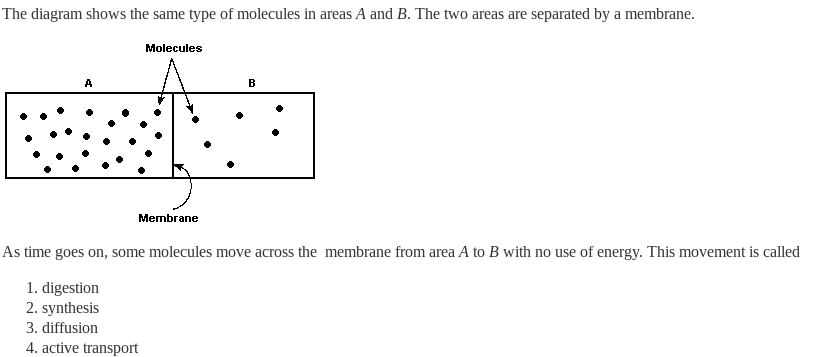
3. diffusion
Nutrition involves those activities by which an organisms 1. remove cellular wastes 2. exchange gases with their environment 3. obtain and process materials needed for other activities 4. absorb and circulate materials
3. obtain and process materials needed for other activities
Which compound is inorganic? 1. glucose (C6H12O6)
2. carbon dioxide (CO2) 3. methane (CH4)
4. Stearic acid (C18H36O2)
2. carbon dioxide (CO2)
An organelle differs from an organ in that an organelle 1. is a substructure of a cell 2. contains one specific type of tissue 3. is larger than an organ 4. cannot be stained
1. is a substructure of a cell
Which structure includes all of the others? 1. nucleolus 2. nucleus 3. chromosomes 4. genes
2. nucleus
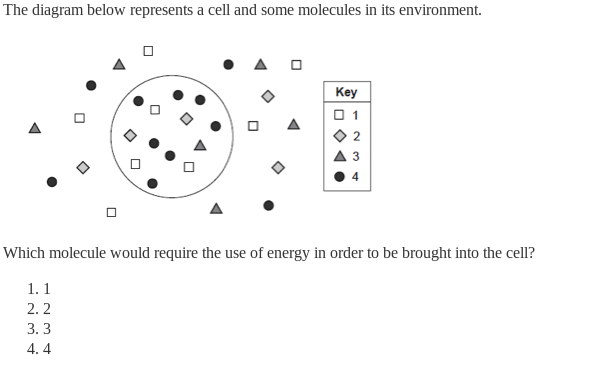
4. 4
Which term is defined as all of the chemical reactions that are required to sustain life? 1. synthesis 2. regulation 3. nutrition 4. metabolism
4. metabolism
A fully functioning enzyme molecule is arranged into a complex three-dimensional shape. The shape determines the... 1. specific type of molecule it interacts with during a reaction 2. rate at which the enzyme breaks down during a reaction it regulates 3. pH of all body system 4. temperature of the products of the reaction it regulates.
1. specific type of molecule it interacts with during a reaction
Which sequence illustrates the increasing complexity of levels of organization in multicellular organisms? 1. organelle->cell->tissue->organ->organ->system-> organism 2. cell-> organelle-> tissue-> organ-> organ system-> organism 3. organelle-> tissue ->cell ->organ-> organ system-> organism 4. cell ->organism->organ system->organ->tissue->organelle
1. organelle->cell->tissue->organ->organ->system-> organism
Most cell membranes are composed principally of 1. DNA and ATP 2. proteins and lipids 3. chitin and starch 4. nucleotides and amino acids
2. proteins and lipids
Cell membranes are said to be selectively permeable. Which statement best explains what selectively permeable means? 1. The cell membrane prevents harmful substances from entering the cell. 2. the cell membrane lets certain substances enter the cell and keeps certain substances out of the cell. 3. The cell membrane allows only large molecules to diffuse into the cell 4. The cell membrane has pores that only let water and glucose into the cell and carbon dioxide out.
2. The cell membrane lets certain substances enter the cell and keeps certain substances out of the cell.
After eating a meal, blood sugar levels are elevated. The body secretes hormones to help absorb excess sugar into cells and return blood sugar levels to normal. This is an example of 1. Excretion 2. Regulation 3. Synthesis 4. Reproduction
2. Regulation
 The building blocks for this molecule are 1. amino acids 2. simple sugars 3. fats 4. moleculare bases
The building blocks for this molecule are 1. amino acids 2. simple sugars 3. fats 4. moleculare bases
2. simple sugars
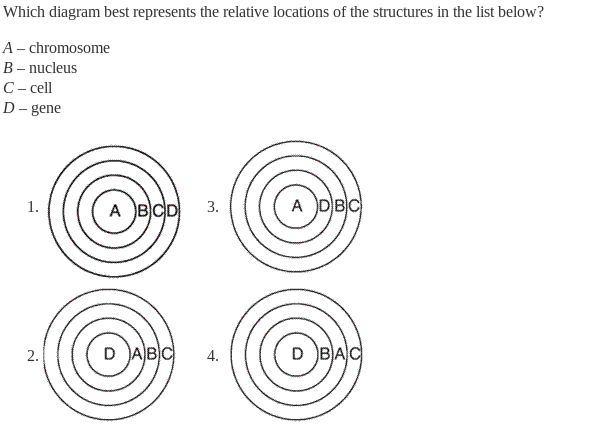
2.
Which structure is usually present only in animal cells? 1. vacuole 2. cell wall 3. nucleus 4. centriole
4. centriole
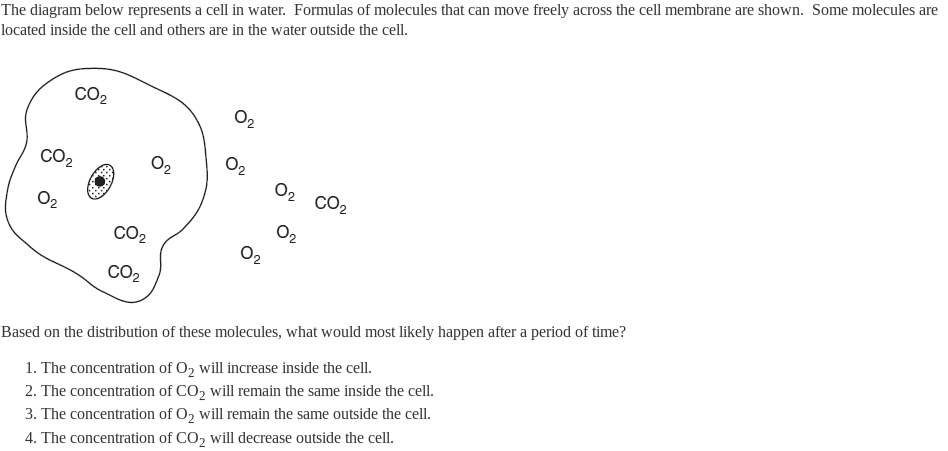
1. the concentration of O2 will increase inside of the cell
Homeostatic control of the body is made possible through the coordination of all body systems. This coordination is achieved mainly by 1. respiratory and reproductive systems 2. skeletal and excretory systems 3. nervous and endocrine systems 4. circulatory and digestive systems
3. nervous and endocrine systems
How are glucose molecules produced by green plants usually processed? 1. converted into starch by dehydration synthesis and stored in roots 2. converted into cellulose by hydrolysis and stored in roots 3. used as catalysts for metabolic activity 4. used as raw material for photosynthesis
1. converted into starch by dehydration synthesis and stored in roots
Which groups are arranged in correct descending order according to a modern classification system?
1. kingdom, genus, phylum, species
2. phylum, kingdom, species, genus
3. kingdom, phylum, genus, species
4. phylum, genus, species, kingdom
3. kingdom, phylum, genus. species
Normally, in the process of osmosis, the net flow of water molecules into or out of the cell depends upon differences in the 1. concentration of water molecules inside and outside the cell 2. concentration of enzymes on either side of the cell membrane 3. rate of molecular motion on either side of the cell membrane 4. rate of movement of insoluble molecules inside the cell
1. concentration of water molecules inside and outside the cell Osmosis is the diffusion of water across a membrane and is a passive process. Therefore, movement occurs due to a concentration gradient set up on either side of the membrane. If there is more water inside the cell than outside, water tends to move out.
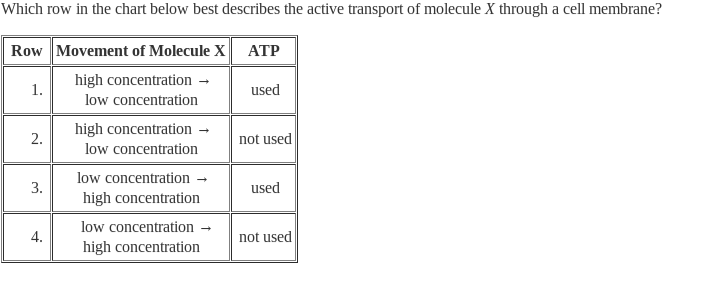
3